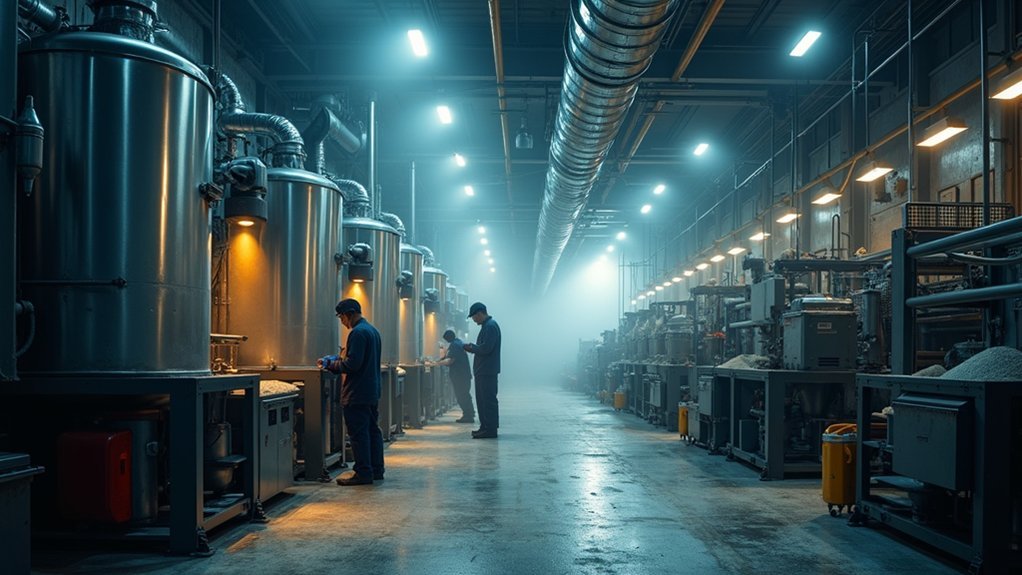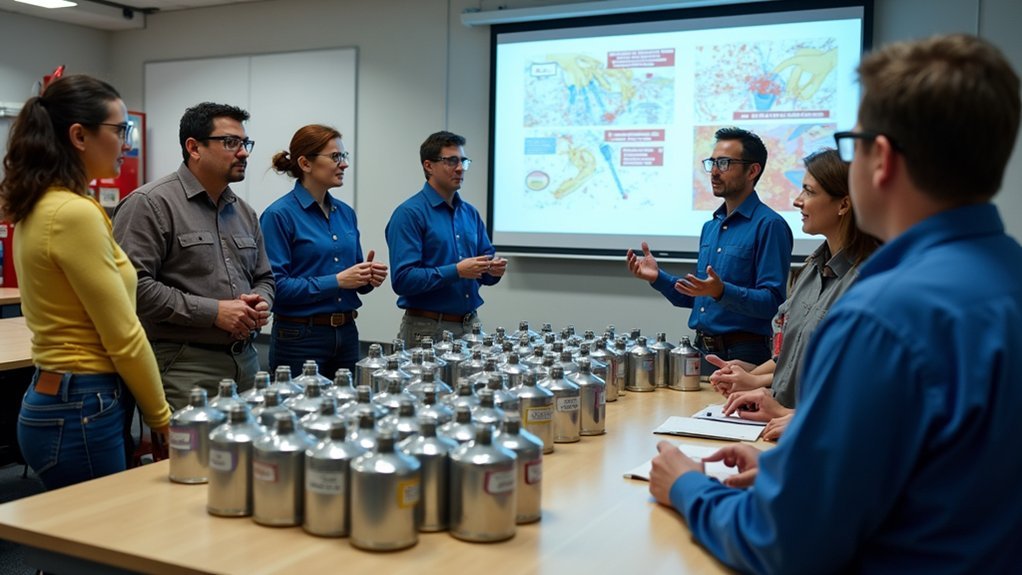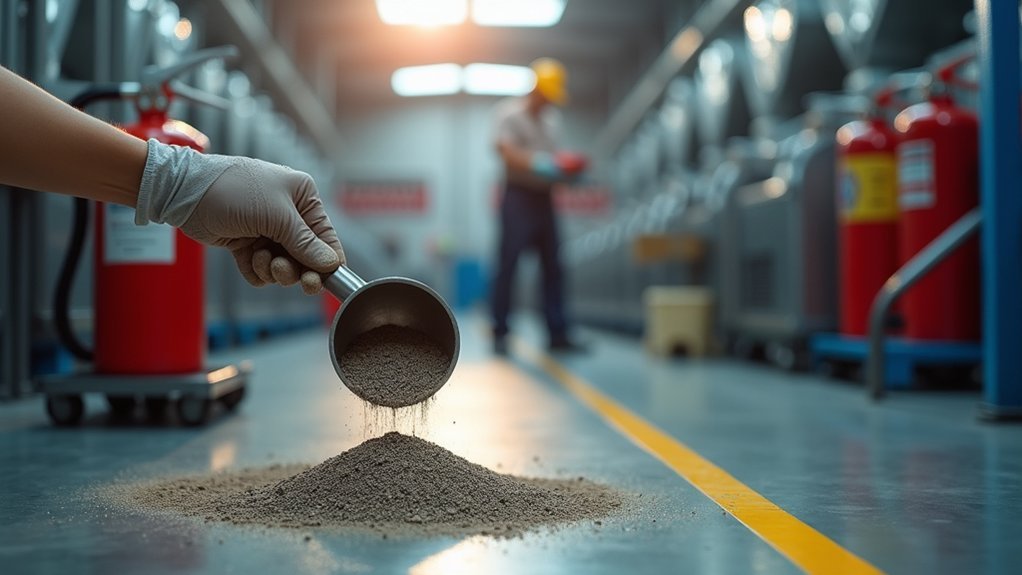You must implement proper personal protective equipment including anti-static, fire-resistant clothing and breathing protection systems to prevent inhalation hazards. Establish controlled storage environments using inert atmospheres like nitrogen or argon to reduce explosion risks. Maintain thorough dust control and ventilation systems with detectors and explosion vents following OSHA regulations. Deploy specialized fire suppression systems designed for metal powder hazards with inert gas integration. Execute regular training and emergency response protocols to guarantee your team understands proper safety procedures and equipment operation.
Implement Proper Personal Protective Equipment and Anti-Static Measures

When handling metal powders, you must prioritize proper personal protective equipment to safeguard against the unique hazards these materials present.
Anti-static materials are essential for your clothing to prevent electrostatic discharge that could ignite combustible dust clouds. You’ll need fire-resistant materials in your PPE to protect against burns and heat exposure from reactive metal powders.
Anti-static and fire-resistant clothing materials are critical PPE components when working with reactive metal powders to prevent ignition and burns.
Breathing protection systems with appropriate filters are vital for preventing inhalation of hazardous particles that pose serious health risks.
Don’t underestimate the importance of regular training, as many facilities fail to meet recommended PPE standards, increasing safety risks considerably.
Ensure your workplace maintains OSHA compliance by following established regulations.
This thorough approach to health and safety protects you from metal powder hazards effectively.
Establish Controlled Storage Environments With Inert Atmospheres
Beyond personal protection, you must create safe storage conditions that eliminate ignition sources at their core. Controlled storage environments with inert atmospheres using nitrogen or argon dramatically reduce fire and explosion risks when handling combustible metals like aluminum and magnesium. These low-oxygen environments prevent oxidation and minimize metal powders’ combustibility.
| Storage Method | Fire Risk | Worker Safety |
|---|---|---|
| Standard air storage | Extremely high | Constant danger |
| Partial inert coverage | Moderate risk | Ongoing concern |
| Full inert atmosphere | Minimal risk | Protected environment |
| Monitored inert system | Lowest risk | Maximum safety |
| Integrated fire suppression | Thorough protection | Peace of mind |
Install monitoring devices to track gas concentrations and maintain consistent oxygen levels. Regular system maintenance guarantees compliance with safety standards like NFPA 484, protecting your facility and personnel from combustible dust hazards.
Maintain Comprehensive Dust Control and Ventilation Systems

Since airborne metal particles pose immediate explosion risks, you must implement robust dust control and ventilation systems that actively capture and remove combustible particles before they accumulate to dangerous levels.
These systems protect the safety of workers by maintaining proper air quality and preventing hazardous materials from reaching ignition thresholds.
Your thorough approach should include:
- Installation of dust detectors and explosion vents throughout ventilation systems to provide early warnings and emergency pressure relief during potential dust explosions.
- Regular maintenance schedules for all dust control equipment to prevent dangerous particle buildup and system failures.
- OSHA regulations compliance ensuring your metal powder handling facilities meet all required safety standards.
Proper ventilation design actively removes combustible dust while protecting workers from inhalation hazards and maintaining safe operating conditions.
Deploy Fire Suppression Systems Designed for Metal Powder Hazards
While traditional fire suppression systems rely on water or foam, metal powder environments require specialized suppression agents that won’t intensify combustion when they contact reactive metals like aluminum or magnesium.
You must deploy fire suppression systems specifically engineered for metal powder hazards to protect your facility and guarantee the safety of their workers.
Install explosion vents and suppression systems following NFPA 484 guidelines to prevent catastrophic dust explosions.
Integrate inert gas systems using nitrogen for oxygen displacement, reducing combustible dust ignition risks.
Ascertain your emergency response protocols include proper protective equipment (PPE) procedures.
Regular maintenance and testing guarantee system reliability in harsh operating conditions.
Your fire suppression strategy must comply with OSHA combustible dust regulations, tailoring protection to your specific metal powder properties and associated hazards.
Execute Regular Training and Emergency Response Protocols

Although fire suppression systems provide critical protection, you must establish extensive training programs that prepare your workforce to prevent incidents and respond effectively when emergencies occur.
Fire suppression systems are essential, but comprehensive workforce training remains the cornerstone of effective incident prevention and emergency response.
Your training sessions should thoroughly educate personnel about dust hazards, emphasizing inhalation, ingestion, and skin contact risks while highlighting proper Personal Protective Equipment (PPE) usage.
Develop robust emergency response protocols covering:
- Combustible dust explosion procedures – Practice swift evacuation and containment strategies
- Safety equipment operation – Train staff on fire suppression systems and ventilation controls
- Hazard identification – Teach recognition and mitigation of ignition sources
Regular drills ensure your team understands metal powders handling protocols and their emergency roles.
Use Safety Data Sheets during training and conduct routine assessments to maintain readiness for potential incidents.
Frequently Asked Questions
What Are the Safety Considerations When Handling Metal Powders?
You must wear anti-static, fire-resistant PPE with respiratory protection, use fire-rated storage, implement ventilation systems, prevent dust clouds, maintain equipment regularly, and avoid electrostatic discharge to safely handle combustible metal powders.
What PPE Is Needed for Metal Powder?
You’ll need anti-static clothing, respirators with proper filters, safety goggles or face shields, and fire-resistant gloves. Don’t forget thorough training on correct PPE usage to prevent exposure injuries.
How to Safely Handle Aluminum Powder?
You’ll need anti-static PPE including gloves and respirators. Store aluminum powder in moisture-proof containers away from heat sources. Maintain proper ventilation to prevent explosive dust clouds and regularly inspect equipment.
What Are the Hazards of Powder Handling?
You’ll face inhalation risks from airborne particles, skin and eye irritation from direct contact, fire hazards from combustible dust clouds, explosion dangers from static electricity buildup, and toxic exposure from reactive metals.





Leave a Reply